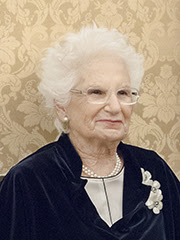Schoolgirl who was spared after family killed
Holocaust survivor Liliana Segre, who was one of only a small number of Italian children to return home after being deported to the Auschwitz concentration camp during the Second World War, was born on this day in 1930 in Milan.
Liliana Segre did not begin to share
her memories until in her 60s
Now a life member of the Italian Senate, Segre was shipped to the notorious camp in Nazi-occupied Poland when she was 13 years old, one of 776 Italians aged 14 and under to be sent to Auschwitz. Only 35 survived.
Forced to work in a munitions factory, she was twice moved to other camps during her time as a prisoner before being freed in May 1945, shortly after the Nazis surrendered to the Allies.
Born in to a successful Jewish family involved in the textile and leather goods industry, Liliana grew up in an apartment in Corso Magenta in the centre of Milan, not far from the Castello Sforzesco, to which her father, Alberto, had moved with his parents following the death of her mother, Lucia, from cancer when Liliana was still a baby.
She was unaware of being Jewish until the Fascist government introduced racial segregation laws in 1938, at which point she was expelled from her primary school.
 |
| Liliana as a child with her father, Alberto, at home in Milan in the 1930s |
In January 1944, she and her father were taken to Milano Centrale railway station and taken to the underground platform - platform 21 - normally used by mail trains and herded into cattle trucks bound for Auschwitz. On arrival at the camp seven days later, Segre was immediately separated from her father, whom she never saw again. Records show that he was killed in April of that year.
The following month, her paternal grandparents, who had found refuge in the town of Inverigo, north of Milan, were arrested and similarly deported to Auschwitz, where they also died soon after arrival.
Segre lost four other family members who were deported by the Fascist government from Italy yet herself survived, having been moved to two different camps in northern Germany before she was liberated.
After the war, she lived with her maternal grandparents, who had escaped capture by hiding in a convent in Rome, in the Marche region before being adopted by her father’s brother, Amedeo, who began another textile business that eventually became successful.
 |
| One of the last family pictures of Liliana before she was deported in 1943 |
She recalled her experiences only privately until the early 1990s, when she decided the time was right to begin to share her memories with wider audiences, at first addressing schools and universities, later larger conferences.
She has collaborated with many books, films and TV documentaries and her contribution to Italy’s understanding of what happened to her among an estimated 7,600 Italian Jews who died at Auschwitz and associated camps was recognised on 19 January 2018, the 80th anniversary of the Italian Racial Laws, when the Italian president, Sergio Mattarella, appointed her as a Senator for Life.
Liliana Segre is the fourth woman to hold such a position, after Camilla Ravera, Rita Levi-Montalcini and Elena Cattaneo. In her role, she has been instrumental in setting up a parliamentary commission on racism, anti-Semitism and incitement to hatred and violence.
Regrettably, after receiving numerous threats to her personal safety, she had to be assigned a bodyguard in 2019 but has continued to have a high public profile. Earlier this year, on the 75th anniversary of the liberation of Auschwitz on 29 January, she spoke before the European Parliament, where she was given an ovation by the full assembly.
Travel tip:
The Castello Sforzesco is
one of Milan's major sights
The Castello Sforzesco, which is close to where Liliana Segre grew up and where she lives now, is one of the main sights for visitors to Milan, situated to the northwest of the city centre, with the Parco Sempione behind it. Francesco Sforza built it on the site of the Castello di Porta Giovia, which had been the main residence in the city of the Visconti family, from which Francesco was descended. The Viscontis ruled Milan for 170 years. Renovated and enlarged a number of times in subsequent centuries, it became one of the largest citadels in Europe and now houses several museums and art collections.
Travel tip:
Milan's Naviglio Grande is lined with bars
and restaurants that make it popular at night
The textile factory in which Liliana’s grandfather, Giuseppe, worked as a young man in the late 1890s was in the Navigli district, an area to the southwest of central Milan that originally consisted of five canals used for commercial transport in the city that date back to the Middle Ages. Their importance declined in the last century and only two - Naviglio Grande and Naviglio Pavese - still exist. Once a poor neighbourhood, the Navigli is now very popular for the restaurants and bars that line the two waterways and is often thronged with young Milanese in the evenings.
Also on this day:
1887: The birth of Giovanni Gronchi, Italy’s third president
1890: The birth of fashion designer Elsa Schiaparelli
1960: At the Rome Olympics, Abebe Bikila becomes the first sub-Saharan African to win a gold medal






















